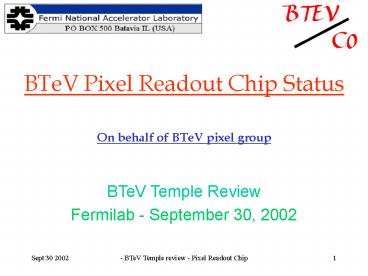BTeV Pixel Readout Chip Status - PowerPoint PPT Presentation
1 / 13
Title:
BTeV Pixel Readout Chip Status
Description:
BTeV Temple review - Pixel Readout Chip. 2. Outline of the talk ... TSMC (Taiwan Semic. Man. Corp.) 0.25um CMOS, 5 metal, 2.5V. 'Rad-Hard' layout. ... – PowerPoint PPT presentation
Number of Views:42
Avg rating:3.0/5.0
Title: BTeV Pixel Readout Chip Status
1
BTeV Pixel Readout Chip Status
- On behalf of BTeV pixel group
BTeV Temple Review Fermilab - September 30, 2002
2
Outline of the talk
- Next BTeV pixel readout chip submission.
- FPIX2 chip
- FPIX history
- Irradiation test on chips prototypes
- Total dose
- Single Event Effects
- Detector assembly
- Conclusions
3
FPIX2 October 2002 submission
Test outputs
- FPIX2 submission this month (Oct. 02)
- TSMC (Taiwan Semic. Man. Corp.)
- 0.25um CMOS, 5 metal, 2.5V.
- Rad-Hard layout.
- BTeV Full-sized chip.
- All the functionalities required by BTeV.
- Submission based on the successful results of
smaller-scale chip prototypes. - One row of 70 pads for wire bonding.
- Internal bond pads for chip Id.
22 cols by 128 rows
Chip periphery
Internal bond pads for Chip ID
4
FPIX2 block diagrams
- Front End cell
- FE optimized for 132 ns BCO.
- DC leakage current compensation.
- 3 Bit Flash ADC/cell.
- Other main functional blocks
- Kill and charge-injection shift-regs.
- 4 timestamp regs in End of Column.
- High speed data driven column architecture.
- High speed data output serializer (1,2,4, or 6
lines 140 Mbits-1line-1,). - Programmable biases and thresholds by DACs.
- LVDS I/O signals.
- Robust absolute chip addressing (no
daisy-chain).
- All circuit blocks tested. Complete functionality
at - Full speed.
- Before and after irradiation.
5
FPIX history
- 1997 FPIX0, 12x64 array, HP 0.8 um CMOS
- Two stage front-end, analog output digitized off
chip, data driven non-triggered Readout. - Successfully used in beam tests.
- 1998 FPIX1, 18x160 array, HP 0.5 um CMOS
- Two stage front-end, 2 bit FADC/cell.
- Fast triggered/non triggered R/O.
- Successfully used in beam tests.
- 1999 PreFPIX2_T, 2x160 array, TSMC 0.25 um CMOS
- New leakage compensation strategy implemented in
radiation tolerant techniques. - 3 bit FADC/cell.
- g irradiation to a total dose of 33 Mrad.
- 2000 PreFPIX2_I, 18x32 array, CERN 0.25 um CMOS
- Complete fast non-triggered RO.
- p irradiation tests to a total dose of 26 Mrad.
- PreFPIX2_Tb 18x32 array, TSMC 0.25 um CMOS
- Programmable 14 x 8 bit DACs.
- p irradiation tests to a total dose of 87 Mrad
and SEU tests. - 2002 Data output interface prototype, TSMC 0.25
um CMOS - LVDS drivers.
6
Total Dose Tolerance
- Threshold shifts g and hadrons.
- Small as expected.
- Surface leakage currents g and hadrons.
- Negligible by design (gate all around NFETs and
guard rings). - Bulk damage hadrons.
- Small, manageable, increase in leakage due to
parasitic device formation. - High statistics with 200 MeV protons exposure
- Four chips exposed up to 26 Mrad.
- Two chips exposed up to 14 Mrad.
- Two chips exposed up to 29 Mrad.
- One chip exposed up to 14, 43, and 87 Mrad.
- All cells worked before and after exposure
(screened up to 4032 Front-End cells)
7
Noise distribution among cells from most
irradiated chip.
Threshold distribution among cells from most
irradiated chip.
Qover-drive150e- TW 130 ns
Time walk performance very good before and after
irradiation.
8
Deviation from the linearity of the first
threshold DAC vs total dose.
Linear fit of the DAC response before irradiation
Deviation of DAC response for various doses
respect to the linear fit done before irradiation
- Non-lin. before irr. about 0.2
- Non-lin. after 87 Mrad about 3
9
Single Event Effect Tolerance
- Catastrophic events gate rupture, latch up.
- None observed ? rate guaranteed to be acceptable
to BTeV. - Soft errors Single Event Upset (SEU).
- Small cross sections per bit measured
- From 1 to 6x10-16 cm2bit-1 for static registers.
- About 2x10-15cm2bit-1 for 140 MHz clock
registers.
Expected SEU error in one hour in pixel vertex
detector at the nominal luminosity of
L2E32cm-2s-1. ? no need for redundant logic or
other design measures.
10
Experimental SEU error tables
Static registers
- Most chips facing the beam.
- Two chips at 450 and 1800.
- One chip indium bump bonded to sensor array.
- All data statistically consistent.
transition from 0 to 1 transition from 1 to
0
Dynamic registers
- Test done at nominal speed of 140 Mbit/s
line. - No word errors for 12 hours after a dose of 29
Mrad with beam off.
11
LVDS drivers
Patter Generator
LVDS to CMOS
LVDS driver
Scope
Single ended random pattern
LVDS signals drive 50 feet flat-end-twisted cable
- FPIX readout chips is the only active device on
the module. - 30 feet Copper point-to-point links will connect
the FPIX chips to FPGAs located behind the
magnet.
Reference clock 70 MHz
140Mbit/s 64kbit random pattern output after 50
feet
140Mbit/s eye-pattern of on-chip LVDS drivers
after 50 foot flat-and-twisted cable.
12
Rad-hard detector assembly
Xray sources e- Tb, Ag, Rb
Pulser relative calibration V
CiS-moderated-pspray
preFPIX2Tb
Threshold dispersion 340 e- Average noise 110
e-
13
Conclusions
- The current design has been prototyped by circuit
element on successfully smaller-scale chips. - Now, it is time to put all the elements together
and submit a full-sized pixel readout chip
meeting all the BTeV requirements. - The full-sized chip, with all the connections
to the outside in their expected layout, will
allows us to do - Multi-chip modules with the BTeV vertex detector
layout. - System-level tests such as noise and rf pickup.

